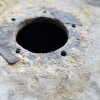I have a 2006 Sportsman that has just recently last 2 years developed a water in the fuel problem. I have had the tank drained several times changed all the filters and lines as well. The water continues to get into the fuel cannot figure where it’s coming from. Any ideas help would be appreciated.
You are using an out of date browser. It may not display this or other websites correctly.
You should upgrade or use an alternative browser.
You should upgrade or use an alternative browser.
Water in fuel
- Thread starter Raybo59
- Start date
DennisG01
GreatGrady Captain
- Joined
- Sep 1, 2013
- Messages
- 7,818
- Reaction score
- 1,543
- Points
- 113
- Location
- Allentown, PA & Friendship, ME
- Model
- Offshore
I think my definition of "just recently" might be different than yoursjust recently last 2 years developed a water in the fuel problem.
Common sources of water leak are:
-- Fuel cap (deteriorated o-ring/no o-ring)
-- Fuel sender seal bad... water can get there from a leaking hatch seal and/or condensation
-- Corroded gas tank
How much fuel? If it's a small amount, it could be condensation inside the tank and/or atmospheric absorption from ethanol fuel.
Changed the boring on the cap. It’s had water with almost full tank/ half tank does it with any amount of fuel. How do I tell if I have a corroded tank. Have been using non ethanol fuel.I think my definition of "just recently" might be different than yours
Common sources of water leak are:
-- Fuel cap (deteriorated o-ring/no o-ring)
-- Fuel sender seal bad... water can get there from a leaking hatch seal and/or condensation
-- Corroded gas tank
How much fuel? If it's a small amount, it could be condensation inside the tank and/or atmospheric absorption from ethanol fuel.
DennisG01
GreatGrady Captain
- Joined
- Sep 1, 2013
- Messages
- 7,818
- Reaction score
- 1,543
- Points
- 113
- Location
- Allentown, PA & Friendship, ME
- Model
- Offshore
At only 13 years old, I'd be surprised if it was corroded. But, the only way to tell if the tank is corroded is to physically inspect it and possibly pressure test it.
wspitler
GreatGrady Captain
- Joined
- May 16, 2011
- Messages
- 1,431
- Reaction score
- 338
- Points
- 83
- Location
- Inglis, FL
- Model
- Express 330
I've had a similar problem over a few years. Changed O-rings on the caps, covered them with plastic bags when kept on the lift. Inspected the tanks externally, they look near perfect on the tops for sure. Corrosion on the sides or bottom would cause fuel leakage, not water entry. (bilges are dry) Only two sources left are water in the fuel as received from the pump or condensation. I checked for water at the gas pump by filling my portable 28 gallon tanks, letting them sit, and sampling them. Never found any water that way. However, after high humidity conditions, I would occasionally get "water in the fuel" warnings from the F250 engine filters. I run each engine off a separate tank (Starboard engine=Main 195 gal tank, Port engine=Aux 150 gal tank) I have had warnings from fuel supplied by both the tanks and found up to 16 ozs of water in the separators each time. Once I clear it up, I may not get another warning for 6-12 months. With two boats, I only run the Grady 75-100 hours per year. Seems to occur more on hot, humid summer months. I carry two spare yamaha fuel separators (the larger ones) and a glass jar on every trip. My theory is condensation. Larger, less than full tanks, are more prone to the problem. I've seen similar problems with aircraft fuel tanks, but they are usually drained from the low point after sitting for any length of time. If I keep the tanks full, it seems to lessen the problem but 350 gallons of fuel is a lot to carry around on short hops.
- Joined
- Mar 1, 2006
- Messages
- 3,090
- Reaction score
- 1,387
- Points
- 113
- Location
- Berea, KY/Cross, SC
- Model
- Seafarer
Uncle Joe
Well-Known Member
- Joined
- Aug 15, 2017
- Messages
- 420
- Reaction score
- 152
- Points
- 43
- Location
- Jamaica Bay, NY
- Model
- Offshore
Are you getting your gas at the same place each time? It could be THEIR tanks that are the problem.



